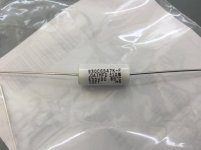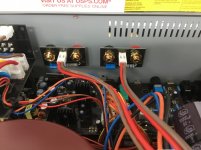Richard, thanks for the pdf....confirms using terminating resistors or RC across speaker terminals huh.
Last edited:
We starting the reflection bridge thing again?
Jn
We should calculate the approximate frequency that docs like that are re-linked here...
Yes thanks for that RM,
So in my case I’ve got .047uf/5.6r where exactly would you introduce the low l 100r ?
Amp side or speaker side?
Oh yah.......happy turkey day!
So in my case I’ve got .047uf/5.6r where exactly would you introduce the low l 100r ?
Amp side or speaker side?
Oh yah.......happy turkey day!
Did anyone noticed what Bateman said about capacitors in his amp's Zobel network? There was some talk about the caps in that Parasound integrated several pages ago. To me they looked marginal, but what do I know..
Also, mountainman bob, did you spotted how many amps Bateman destroyed in the process? 😉Both these and the D. Self amplifier, had specified inadequate, metallised PET capacitors for the output Zobel networks. To sustain 25 watts output at 20kHz requires more capable, AC rated capacitors.
Last edited:
The latest integrated uses a pretty good cap for the Zobel network (metalized polypropylene). I don't know about the earlier one. Pure (non-metalized) polypropylene or polystyrene would be absolutely the best.
I imagine that an energetic and motivated person, would be able to (a) calculate with pencil and paper; and also (b) simulate with SPICE,
the AC current flowing through the output Zobel network, when the amplifier is driving a maximum amplitude, 20 kHz sinewave into an 8 ohm load.
If the amplifier's marketing specifications claim "25W" power output, then maximum amplitude probably occurs when delivering 25.1 watts into an 8 ohm load. Any higher and it begins clipping.
_
the AC current flowing through the output Zobel network, when the amplifier is driving a maximum amplitude, 20 kHz sinewave into an 8 ohm load.
If the amplifier's marketing specifications claim "25W" power output, then maximum amplitude probably occurs when delivering 25.1 watts into an 8 ohm load. Any higher and it begins clipping.
_
Last edited:
The latest integrated uses a pretty good cap for the Zobel network (metalized polypropylene). I don't know about the earlier one. Pure (non-metalized) polypropylene or polystyrene would be absolutely the best.
This is what’s in the earlier model... polyester?
I picked up some Cornell Dubilier 930C (pp) of the same value to try.....still trying to find a better mf resistor than the mox they used.
Attachments
They probably used the same cap in the earlier version. For safety reasons they probably used a 'flameproof' resistor. Another resistor type should be OK. The CD looks OK as well.
My wife’s aunt who is in her mid sixties wears a hearing aid and struggles to hear the TV. So I suggested she gets one of those sound bars with Bluetooth to reduce the wires etc and she can then place next to where her and her husband sit.
She told me she would have to think long and hard about having Bluetooth in the house because of ‘radiation effects’. I told her she has a mobile phone (and the habit bit of talking on it for hours), a microwave etc. No she told me, Bluetooth is different and can be quite dangerous.
She’s into alternative therapies and all that stuff.
How do you educate people like that?
She told me she would have to think long and hard about having Bluetooth in the house because of ‘radiation effects’. I told her she has a mobile phone (and the habit bit of talking on it for hours), a microwave etc. No she told me, Bluetooth is different and can be quite dangerous.
She’s into alternative therapies and all that stuff.
How do you educate people like that?
Too right.
The world is full of techno-quackery peddling crud to people who have no way of understanding this stuff or able to assess its veracity.
:-(
The world is full of techno-quackery peddling crud to people who have no way of understanding this stuff or able to assess its veracity.
:-(
There is a way, sometimes... Find some crystal, goop, or other thing that makes Bluetooth "safe". If she believes in that, job done. Sad but it can work....
Richard, thanks for the pdf....confirms using terminating resistors or RC across speaker terminals huh.
Yep
-RNM
kindly reinforces the differences heard (by some) between speaker wire, and how one might work better than another dependent on amplifier.
Oh, come on, you don't want to bad mouth this forum that much. 😀Too right.
The world is full of techno-quackery peddling crud to people who have no way of understanding this stuff or able to assess its veracity.
:-(
- Status
- Not open for further replies.
- Home
- Member Areas
- The Lounge
- John Curl's Blowtorch preamplifier part III


